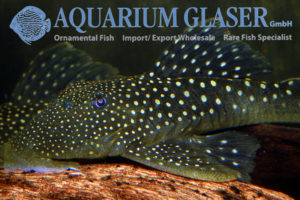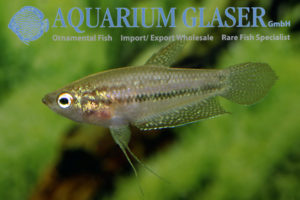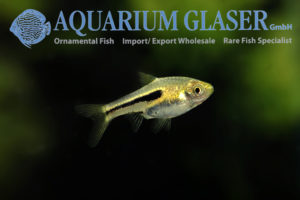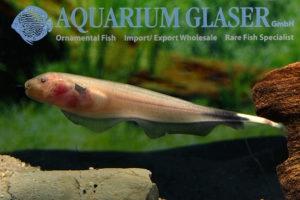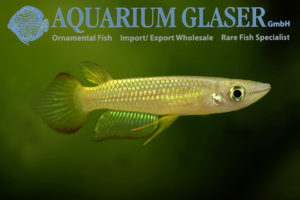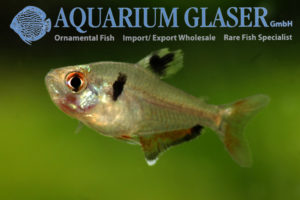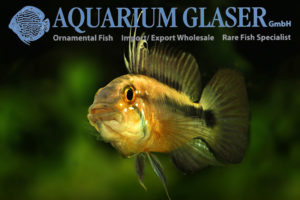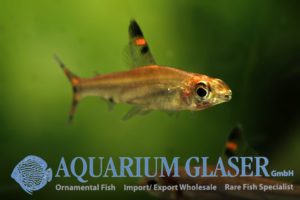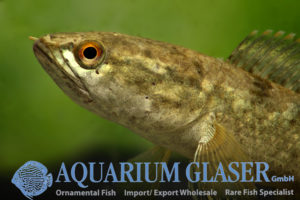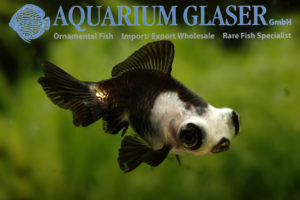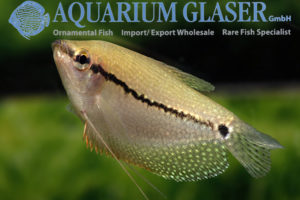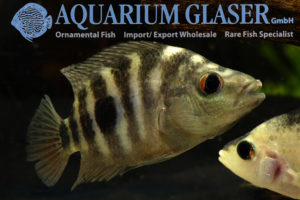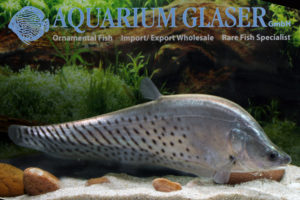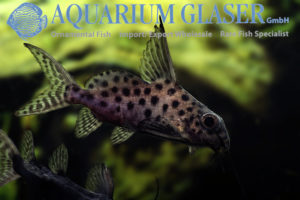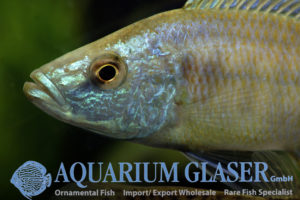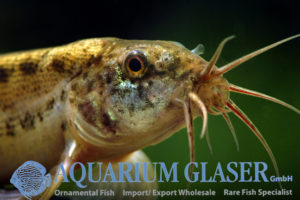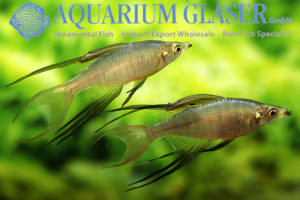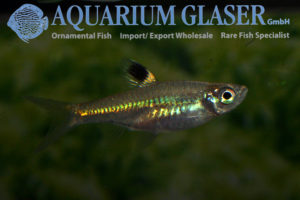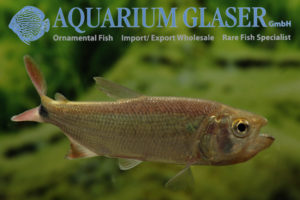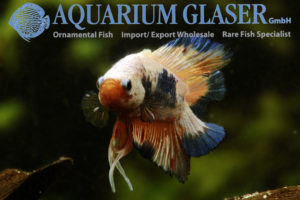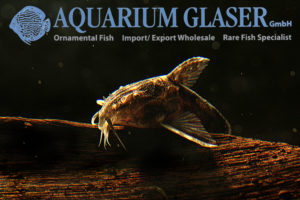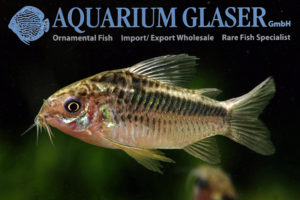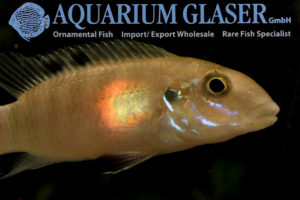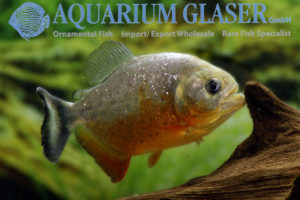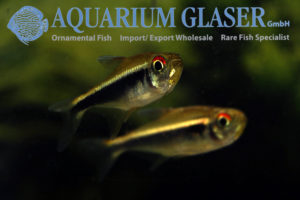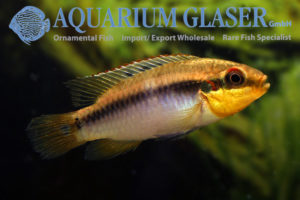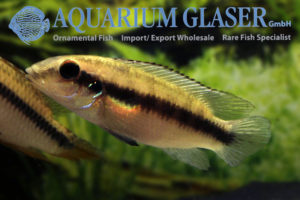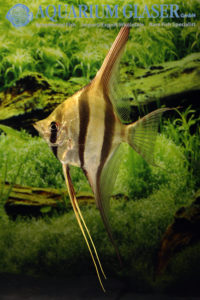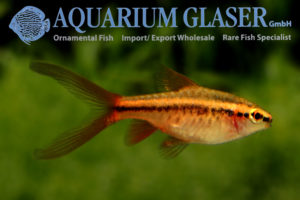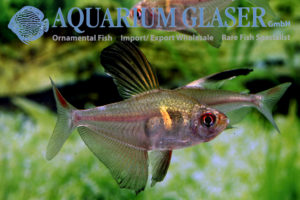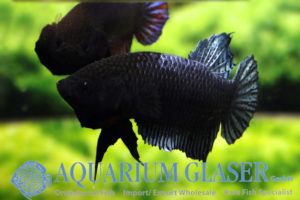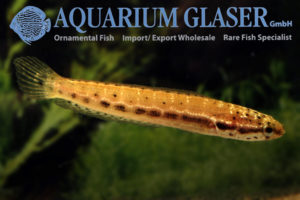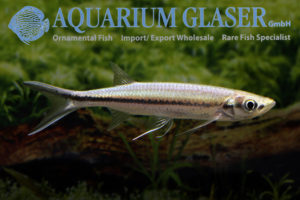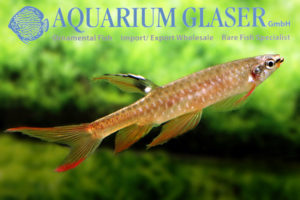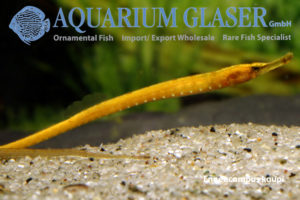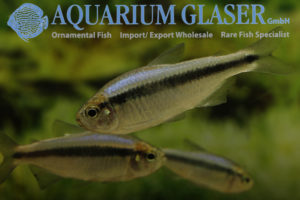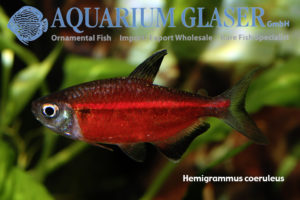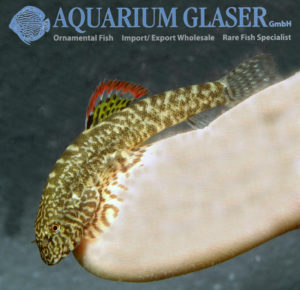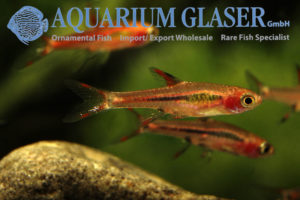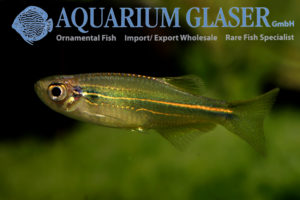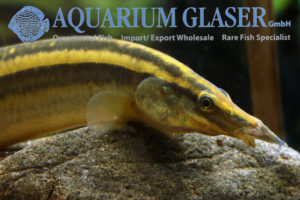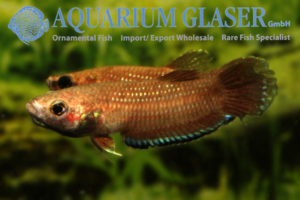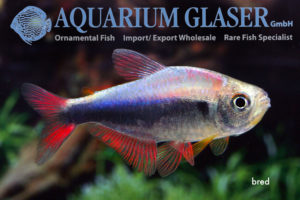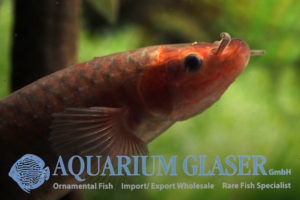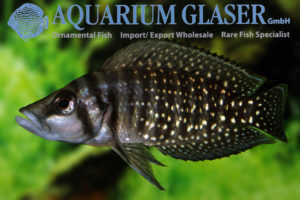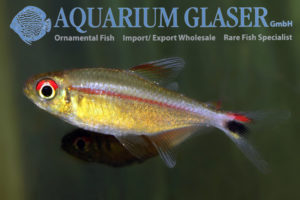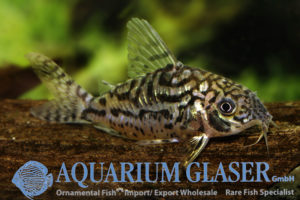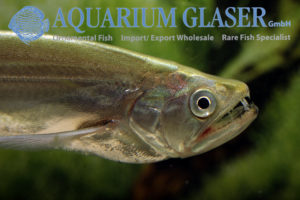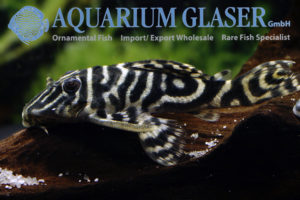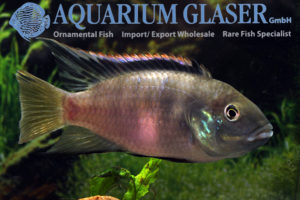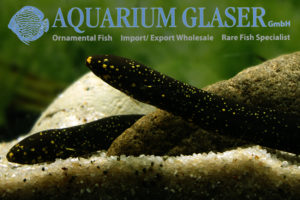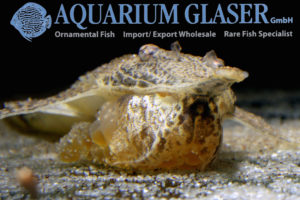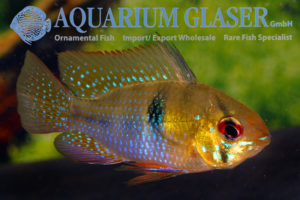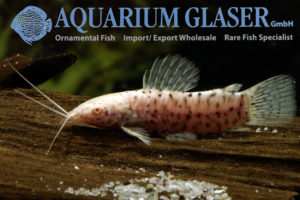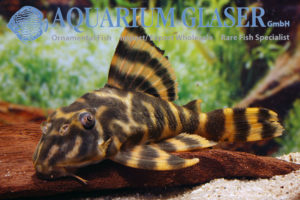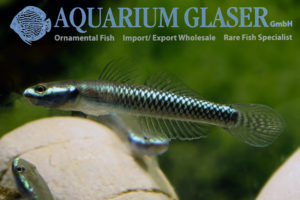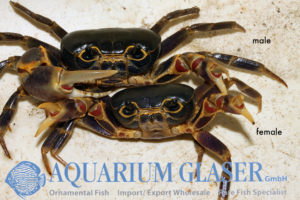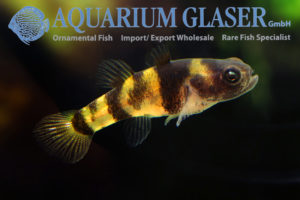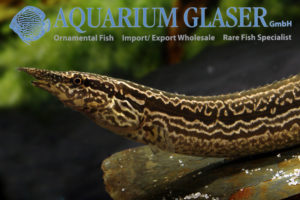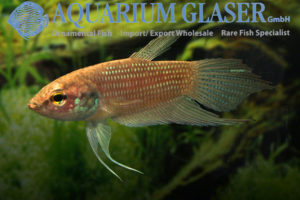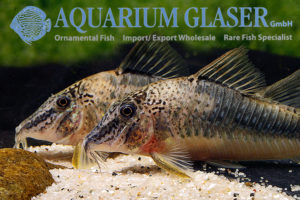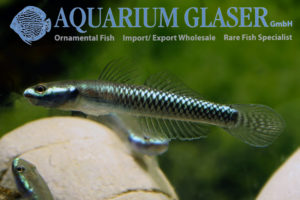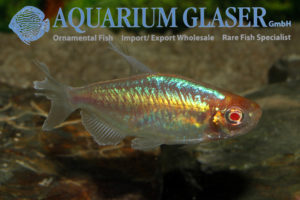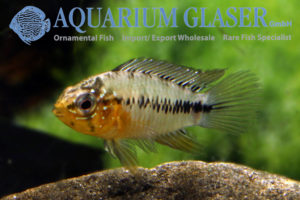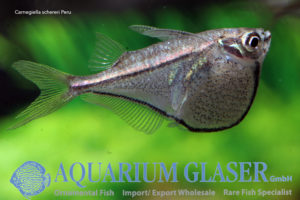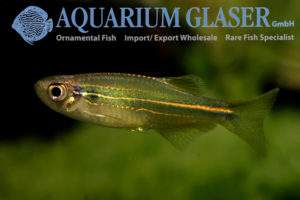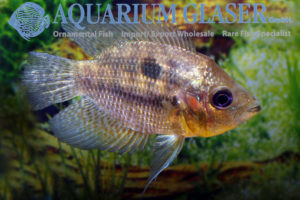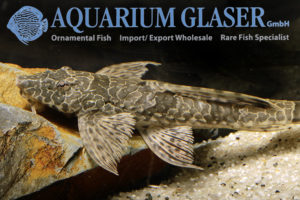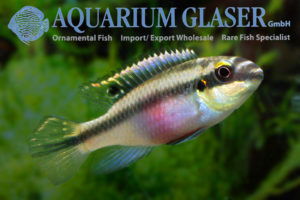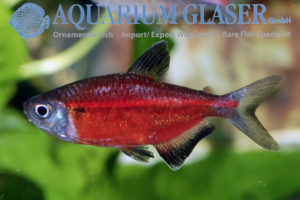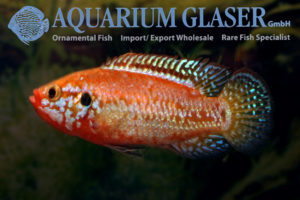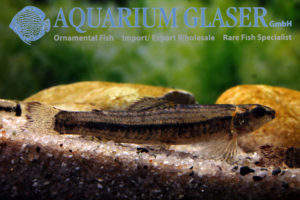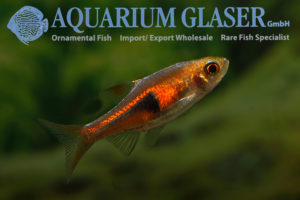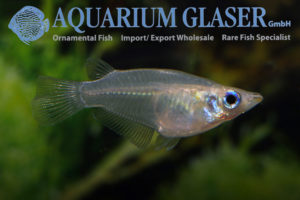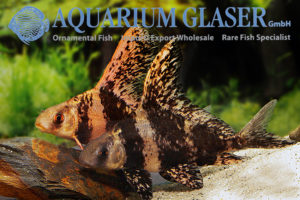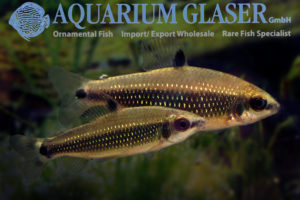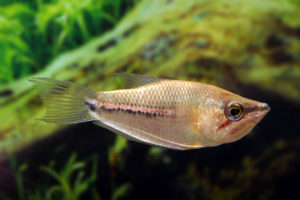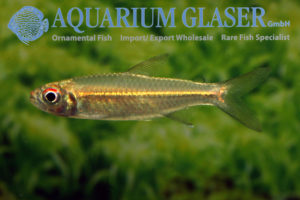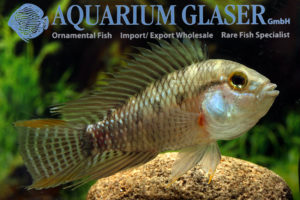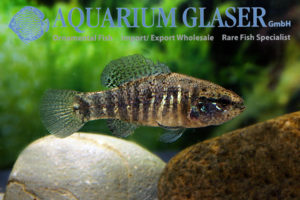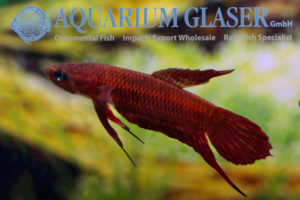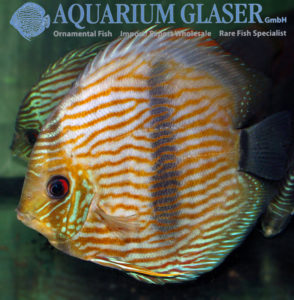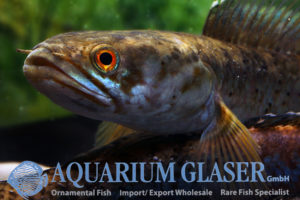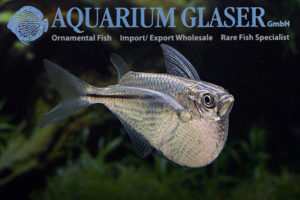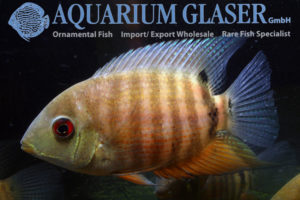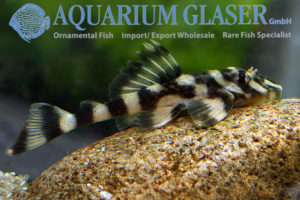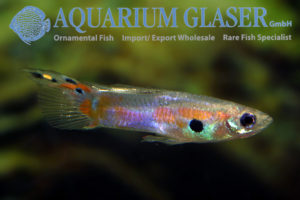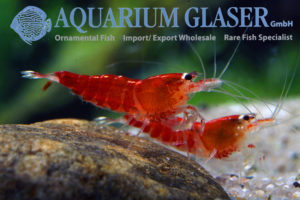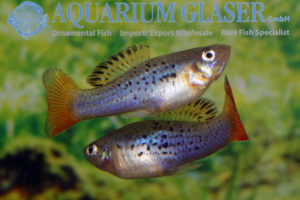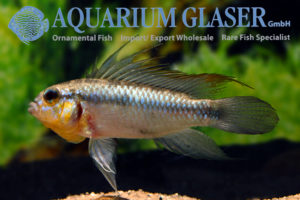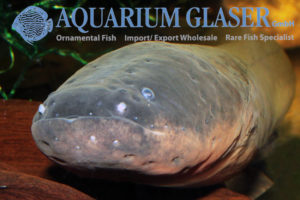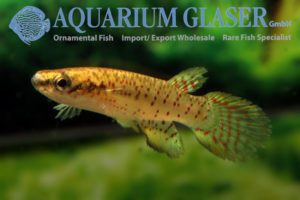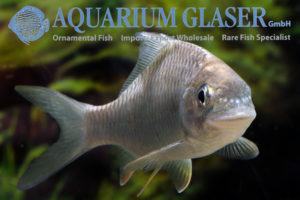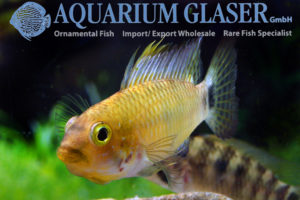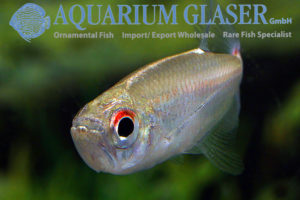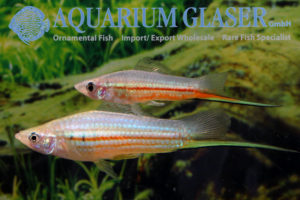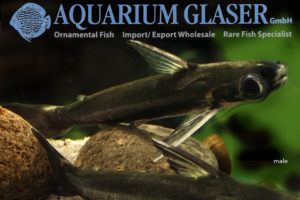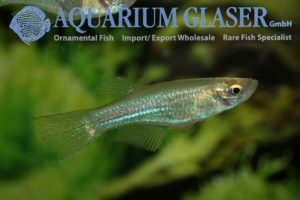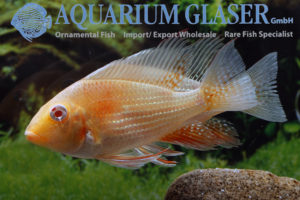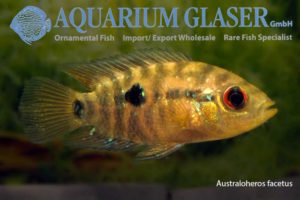Many L-numbers have received correct scientific names in the meantime; not so the „Blue Phantom“, which ist stil undescribed. Currently most keepers tend to place the species in the genus Hemiancistrus, but this is not confirmed. It is also possible that the fish will have to be placed in a new genus (Ancistrinae gen.sp.). We […]
Fish Archive (3044)
-
-
Trichopsis schalleri
Schaller´s Croaking Gourami is sadly only very occassionally available in the trade. The very pretty fish originates from central Thailand; it attains a length of about 4 cm. So it becomes larger than the Croaking Dwarf Gourami (Trichopsis pumila, 2,5-3 cm), but stays smaller than the common Croaking Gourami (T. vittata, up to 6 cm). […]
-
Trigonostigma somphongsi
The Siamese Dwarf Rasbora (Trigonostigma somphongsi, formerly Rasbora somphongsi) has been described scientifically in 1958 on the basis of specimens that were imported by the ornamental fish trade by the end of 1957 from Thailand. So the exact type locality was unknown from the beginning. In the original description nothing but “Thailand” was mentioned, later, […]
-
Apteronotus albifrons WHITE
The Black Ghost (Apteronotus albifrons) is a most beautiful and elegant knifefish from South America. The species has a very wide distribution, wild collected specimens most often come from the Orinoco (Colombia and Venezuela). However, the up to 50 cm long species is also bred since many years in Indonesia on a regular basis. The […]
-
Aplocheilus lineatus “Gold”
The golden sport of Aplocheilus lineatus is very popualr in the aquarium hobby and the only member of the genus that can be found on a regular basis in the petshops. The reason for that is quite simple: the golden sport exhibits even as a small juvenile (3-5 cm length) already the attractive coloration, while […]
-
Hyphessobrycon eques wild
The Serpae tetra is one of the most popular tetras at all. This is doubtless due to its intensive red coloration. In respect of the behaviour one cannot trust them too far. They have the nasty tendency to bite off pieces of finnage from other fish, also from conspecifics. From a scientific point of […]
-
Apistogramma atahualpa
Before its scientific description this beautiful species of dwarf cichlid was known in the hobby as the „Sunset-Apistogramma“. And in fact the body coloration of a female during brood care reminds one in a sunset. The scientific name, atahualpa, refers to the last great ruler of the Inka empire: Atahualpa. He was captured by the […]
-
Monostichodus mesmaekersi
For the first time ever we can offer this pretty and very interesting tetra from the Congo. The species is practically unknown among aquarists. The genus Monostichodus (formerly: Hemistichodus) belongs to the relationship of the subfamily Ichthyborinae (fin eaters). Many members of that group are specialized fish that feed almost exclusively on parts of fins […]
-
Channa harcourtbutleri
We obtained some specimens of this only very rarely offered snakehead from Burma. The species is a very close relative of Channa gachua. In fact, it has been considered to be a mere synonym of C. gachua for a very long time. But Ng, Ng & Britz could show in 1999 that C. harcourtbutleri is […]
-
Carassius auratus Oranda Panda
If one listens to the breeders the black and white goldfish are called „magpie goldfish“, animals with telescope eyes ae called „demekin“ and the fish with a double, but compartively small tailfin are „fantails“. An oranda, on the other hand, is a hooded fish in the language of the breeders. But honestly: who would call […]
-
Trichogaster leerii Wild
For the first time we obtained wild collected pearl gourami from Thailand. This is worth mentioning for several reasons. First, it is very ambigously discussed in the scientific literature wether the species occurs in Thailand at all; twice: the wild populations of the pearl gourami are declining terryfing fast, for the species is strictly adopted […]
-
Amphilophus xiloaensis
In the lakes of Nicaragua a group of cichlids evolved, which is very interesting from a biological point of view: the Midas cichlids. Formerly they were classified only in two or three variable species within the catch-all genus Cichlasoma: Cichlasoma citrinellum, C. labiatum, and C. zaliosum. Nowadays they are placed in the genus Amphilophus. These […]
-
Chitala blanci
The Asian featherbacks, which have a well developed dorsal fin, have been placed in the genus Notopterus for a long time. Nowadays the genus Notopterus is seen monotypic (it contains only the single species N. notopterus) and the high-backed forms have been placed in another genus, namely Chitala. Currently we have the very attractive species […]
-
Synodontis batensoda
There does exist a good number of species of Synodontis that tend to swim upside down. The best known species is without any doubt the upside down cat, Synodontis nigriventris from the Congo. Now we were able to import the very rarely offered Synodontis batensoda from Nigeria, which shows a similar behaviour. It seems to […]
-
Dimidiochromis strigatus
The genus Dimidiochromis comprises currently four accepted species. Only one of them, D. compressiceps, is found in the trade on a regular basis and has become an ornamental fish so far. D. strigatus can still be considered a rarity in the trade. We have the species stocked now for the first time, our fish are […]
-
Misgurnus anguillicaudatus
We received beautiful weather loaches via Hongkong. The genus is characterized by the existence of ten barbels around the mouth. The funny name „weather loach“ was given in medieval times, when these loaches were kept in captivity as weather prophets. These fish breath not only via gills but have an additional breathing technique. When the […]
-
Iriatherina werneri
Currently we have wonderful, fully grown specimens of the Threadfin Rainbowfish in stock. Like a butterfly its wings the male Threadfin Rainbowfish flaps its first dorsal fin during courtship. The males can be easily recognized by the long filaments of the second dorsal and the anal fin. The tender species attains a maximum length of […]
-
Brevibora dorsiocellata
Once more we were able to import this beautiful dwarf rasbora in good numbers. Al large school of them is a fascinating look! The Eyespot Rasbora, Brevibora dorsiocellata, is a well known, classical aquarium fish. Sadly the species became almost forgotten in the 1980ies. It was Mr. Takashi Amano from Japan who was responsible for […]
-
Brycon hilarii
Every year comes a season for one of the most wanted fish or large show aquaria: Salminus maxillosus. And every year we have to look wether the ordered young fish really belong to that species. The Salminus are large (usually up to 60 cm, sometimes reaching even 1 m in length) predatory fishes hat feed […]
-
Another new sport of fighting fish: Fancy Dragon Pla Kat
Fighting fish are absolutely popular currently. The splendid colours, the easy breeding, the interesting behaviour and the unproblematic keeping are the reasons. Against other fish than conspecifics Betta splendens are usually completely peaceful; the only general exception are fancy guppys, as these are often erronously taken for male fighting fish and attacked. Until now the […]
-
Rhynchodoras woodsi
Only very rarely members of the enigmatic genus Rhynchodoras (family Doradidae) appear in the ornamental fish trade. It is believed that these fish live in the very riverbed where collectors of ornamental fishes usually do not fish at all. All species of Rhynchodoras have a strange appendix on the jaw that looks like a share; […]
-
Corydoras elegans “Peru”
We received a small number of this pretty cory from Peru. It was shipped under the nice name „Corydoras Brilliante“. In fact the dark longitudinal band of the fish shines in a bright emerald green when the reflecting light comes in the correct angle, but all in all the fish is „only“ a local variety […]
-
Wallaceochromis signatus
Prior to its scientific description this species as been known in the hobby under the names of Pelvicachromis sp. „Bandi1“ or „Guinea“. The species can be always easily recognized by the black tailspot of the female. Usally the female has only one black spot in the dorsal fin; the fact that the photomodel from our […]
-
Pygocentrus piraya
The „real“ piranha, Pygocentrus piraya, is restricted to the river system of the Sao Francisco in southern Brazil. It is a up to 30 cm long species, which is characterized by its deep red breast and the mighty jaws when it is fully grown.However, even juveniles display a very attractive coloration. Most piranha species belong […]
-
Hyphessobrycon herbertaxelrodi Wild
Wild collected black neon tetra? This is extremely rare, even in our company. The black neon tetra is one of the most often traded ornamental fish at all and much sought for. So it is available any time in any number as bred ones, even some artifical sports have been bred, like „smoke“ or „albino“. […]
-
Pelvicachromis roloffi
The maybe rarest of all dwarf cichlids of the genus Pelvicachromis is P. roloffi. So we are very glad that in our current import from Guinea some specimens were included. This species depicts in almost all different moods a clearly visible, horizontal band. The females are – as usual in Pelvicachromis – the more colorful […]
-
Wallaceochromis humilis „Kasewe“
Finally we were able again to organize an import of – inter alia – dwarf cichlids from Guinea. Formerly all these fish were placed in the genus Pelvicachromis, but the species humilis, signatus, and rubrolabiatus have been transferred to the newly described genus Wallaceochromis in 2016. The naming of the different local populations of these […]
-
Wonderful bred Altum angels available!
The Altum angel (Pterophyllum altum) is extremely demanding during the rearing period. If the breeder makes even a minor mistake in respect of water quality or the food this results at once in a life-long deformation of the fish. These gnarled ventral fins, crooked anal fins or defects of the operculum are not heritable; so […]
-
Puntius titteya „Longfin“
Quite recently a new sport of the cherry barb, Puntius titteya, apperaed in the market. The fish are offered from Southeast Asia. We have imported them now for the very first time. A most intersting fact is that in this sport only the caudal fin is prolonged, the remaining fins have normal size. In all […]
-
Two new tetras from the Rio Negro region: Hyphessobrycon paepkei and H. cf. agulha
In a shipment containing Hyphessobrycon socolofi (Socolof´s bleeding heart) we found an extraordinary large number of bycatches. Allmost half of the shipment were another species, obviously a close relative of H. ornatus (Rosy tetra). We took a closer look and found the the bycatches were the Goldshoulder rosy tetra, H. paepkei. This species has been […]
-
Betta splendens – real fighter Pla Kat Luk Maw
It is a well known fact that the Betta splendens kept in the aquarium hobby as ornamental fish do not represent the species as it appears in the wild, but a domesticated fish. Initially this sport has been bred for combats, similar like sports of cocks and dogs. Only in the 1920ies, when supplying ornamental […]
-
Channa bankanensis
Many species of snakehead look very attractive as juveniles. Channa bankanensis is no exception from that rule. The reason for the sometimes extraordinary change in coloration is the behaviour. Juvenile Channa are usually schooling fish. Depending on the species they swim in close schools up to a length of 3 cm or even 15 cm. […]
-
Luciosoma setigerum
This barb with the extremely aerodynamic shape originates from Indonesia. Despite the size the fish can reach – up to 25 cm – the peaceful and splendid colored fish is an ideal inhabitant for a community tank with other large barbs from Asia, like Bala sharks (Balantiocheilus) or Sahyadria denisonii. For our customers: the fish […]
-
Copella arnoldi
The Splashing tetra (Copella arnoldi) is very famous due to it´s unique way of spawning. The pair jumps out of the water and deposites the eggs on the underside of plant leafes hanging over the water surface (in the aquarium they often spawn on the top glass). After spawning the male guards the clutch and […]
-
Freshwater pipefish from West Africa
There are three species of freshwater pipefish known to occur in West Africa. They live in inland waters along the coast and have a very wide distribution. One can find these fishes from the Senegal to Angola (roughly 16°N to 18°S). The term „West Africa“ is not used here in the sense of the UN, […]
-
Hyphessobrycon melanostichos
In our latest newsletter I made a regattable mistake: I used pictures of Hyphessobrycon cf. melanostichos instead of pictures of the „real“ Hyphessobrycon melanostichos in the post; H. cf. melanostichos differs a lot from the „real“ species in life colours. So here are now pictures of the „real“ H. melanostichos, the fish we currently have […]
-
Tetras: top rarities, German bred
We obtained from our proofed breeder three species of tetra which are hardly – if ever – available in the trade, all German bred. Hyphessobrycon melanostichos, H. nigricinctus, and Hemigrammus coeruleus. Especially H. coeruleus is now available in larger numbers (yippieh!), the remaining two species are only in small numbers in our stock. For our […]
-
Pseudogastromyzon cheni
Now the season for the charming hillstream loaches imported via Hongkong has started. There do exist several species and we also have several species in stock currently. There is a lot of confusion regarding the identity of two species of Pseudogastromyzon, namely P. cheni and P. myersi. Both species look almost identical. And both species […]
-
Boraras brigittae
Dieter Vogt described in 1978 a subspecies of Rasbora urophthalma (please see the entry for Boraras urophthalmoides in our fisharchives: http://www.aquariumglaser.de/en/fish-archives/boraras_urophthalmoides_formerly_rasbora_urophthalma__en/) from Borneo. He named the fish Rasbora urophthalma brigittae, a dedication name in honour for his wife Brigitte. The German name is „mosquito rasbora“. This is not because the fish are as tiny as […]
-
Danio sp. Hikari Blue & Yellow
Hikari-Danios belong to a scientifically still undescribed species of Danio from Burma. The closest relative is Danio kerri. However, Hikari danios are by far more colorful than D. kerri and really beautiful fish. Keeping and breeding Hikari Danios is absolutely comparable to the very well known zebra fish, Danio rerio. Hikari danios attain a maximum […]
-
Macrognathus aculeatus
Once more we obtained from India (Bengal) wonderful Eyespot Spiny Eels. The fish are of adult size and 12-15 cm long. The only complicated thing in this species is the scientific naming. The Eyespot Spiny Eel attains a maximum length of about 20 cm and ist one of the most colourful species of all spiny […]
-
Betta simplex
This small (5-6 cm) mouthbrooding species from Thailand is a very nice addition to the good assortment of wild collected Betta we currently have in stock. Betta simplex is a very close relative to the species Betta picta from Java, Betta falx from Sumatra, and Betta taeniata from Borneo. All the mentioned species share the […]
-
Hyphessobrycon sp. Red-Blue Peru Tetra, now H. margitae
This tetra, which attains a maximum length of about 4-5 cm, is without any doubts one of the most attractive members of the tetra family. The species has been described scientifically recently under the name of Hyphessobrycon margitae. It originates from Peru, according to the exporters from the Loreto region, Rio Nanay basin. Regarding the […]
-
Phractolaemus ansorgii
Finally we were able to import again Phractolaemus ansorgii. The last importation was years ago. Sadly the fish are sold out already, but we nevertheless want to show you the interesting animals. Formerly we obtained these fish from Nigeria, this time they originate from the Congo. In our current import obviously two colour morphs appear, […]
-
Altolamprologus calvus
This cichlid belongs to the most attractive species of the family from Lake Tanganyika. It attains a maximum length of about 13 cm. Despite the lurky look the fish is one of the most peaceful species of cichlid at all. One can say as a rule: if another fish is too large to serve as […]
-
Hemigrammus rubrostriatus
Until now we were able to present this beautiful tetra – which has been described scientifically only in 2015 – to you only as a very rare bycatch (see http://www.aquariumglaser.de/en/fish-archives/hemigrammus-rubrostriatus/). But finally we managed a larger importation of that beauty from Venezuela. The fish are about 4-5 cm longer, adult and in full colour. They […]
-
Corydoras sodalis
We received beautiful coloured Netted Corys. The species Corydoras sodalis is quite often imported, but mostly under the completely wrong name of Corydoras punctatus. The real C. punctatus originates from Surinam, occurs hardly ever in the trade and looks very similar to the well known species C. julii and C. trilineatus. A cory that can […]
-
Rhaphiodon vulpinus
Rhaphiodon vulpinus belongs to the largest of the sabertooth tetras. The species can attain a maximum length of about 80 cm and a weight of up to 2.1 kg. It has a very wide distribution in South America where it is called „Biara“. This predator has, very much alike the close realtives of the genus […]
-
Extraordinary attractive Hypancistrus debilittera (L129) arrived!
Currently is the best import season for plecos from the Rio Orinoco. So we have a large number of species in stock. Among them is of course Hypancistrus debilittera, which was called L129 before it became described scientifically. This is a pretty, small species with an enormous range of colour pattern. There hardly exist two […]
-
Benitochromis nigrodorsalis
We can cvurrently offer a very small number of German bred specimens of a top rarity among the cichlids of western Africa: Benitochromis nigrodorsalis. This species has been described scientifically only in 2001. It originates from Cameroon and the island of Fernando Poo. Prior to the scientific descrption the fish was known as „Chromidotilapia finleyi […]
-
Lepidosiren paradoxus
The South American Lungfish is a very interesting fish, but it has only very drab colours. The usual pattern is mudcolour, eg brownish, greyish, sometimes a bit blackish. But why should an animal that lives in swamps and feeds on snails show bright coloration? On the other hand: astonishingly enough, very young specimens, like the […]
-
Hemiodontichthys acipenserinus
This species has been named “Pinocchio cat” in the trade due to its funny looking nose. The species represents the smallest of all mouthbrooding whiptail cats – it usually grows only to 10 cm total length in aquaria – and is thus very well suited for keeping. We currently were able to import these beautiful […]
-
Wild Rams
Due to the regularly offered, amazing bred sports of the Ram (Mikrogeophagus ramirezi) one tends to forget, how breathtaking beautiful the wild collected fish is already. Currently we have fully grown, wild collected Rams from Venezuela in stock. By the way: wild collected Rams become only about 5 cm long (in males), females even stay […]
-
Megalechis thoracata „Albino“
The Port Hoplo Megalechis thoracata – maybe the synonym (now invalid) name Hoplosternum thoracatum is more familar to some readers – is one of the earliest aquarium fish at all. The fish has only one real disadvantage: the maximum size, which is about 15 cm (or sometimes even larger). However, the species has a comparatively […]
-
Peckoltia sp. Red Tiger L209
When we imported this beauty for the very first time it was not possible to identify it as a already known species. But now there is a consensus among hobbyists that it is identical with L209. L209 is a typical member of the genus Peckoltia. The omnivorous species attains a maximum length of about 15 […]
-
Stiphodon semoni
Once more we were able to import one of the gorgeous gobies belonging to the genus Stiphodon. This time we most likely received Stiphodon semoni, a species that is known for a long time already scientifically. It has been described already back in 1895. The species has a wide distribution, it is known from Sulawesi, […]
-
Laevimon kottelati
We were able to import some specimens of the freshwater crab Laevimon kottelati. This interesting an beautiful crab attains a size of about 4.5 cm Carapax-width aund existis endemicly in Vietnam. Here it has been discovered in 1998 and decribed scientifically in 2005 as a new species in a new genus. It lives amphibic in […]
-
Brachygobius sabanus Thailand
We received this pretty species of bumblebee goby from Thailand. The determination of bumblebee gobies often proofes to be quite tricky; usually a big questionmark has to be set behind the names. Brachybobius sabanus has been described initially from Borneo (Sabah), our fish have been collected in Thailand. But the illustration accompanying the original description […]
-
Mastacembelus sp. „Nargis“
We could import this new discovery – a spiny eel – for the first time now from Burma. Initially I thought it would be a member of the M.-armatus-group, but the specialist for spiny eels, Ralf Britz from Natural History Museum in London led me to the idea to take a closer look on the […]
-
Betta ferox
Sometimes we receive wild collected specimens of that very rare species of Betta. The mouthbrooding species is known so far only from a very small area in Thailand (Bori Pat). Here the fish inhabit brooks with soft and slightly acidic water. The water temperature there is around 25°C. Maximum length reported is about 8 cm, […]
-
Corydoras fowleri / coriatae
The very long snouted Corydoras fowleri has been described scientifically in 1950 on the basis of a single specimen. Since that it has not been seen for decades anymore. Only at the end of the 1990ies imports from Peru arrived. The imported fish proofed to be very variable in respect of coloration. It is still […]
-
Stiphodon semoni
Once more we were able to import one of the gorgeous gobies belonging to the genus Stiphodon. This time we most likely received Stiphodon semoni, a species that is known for a long time already scientifically. It has been described already back in 1895. The species has a wide distribution, it is known from Sulawesi, […]
-
Phenacogrammus interruptus Albino
Currently we receive beautiful cultivated albino Congo Tetras (Phenacogrammus interruptus) from Southeast Asia. Like in all true albinos the eyes of the fish are red due to the genetically caused lack of black body pigment (melanin). In many other species of fish albinos have a uniform whitish, yellowish or flesh-coloured body. Not so in the […]
-
Apistogramma borellii Paraguay wild
Recently we received beautiful wild collected specimens of A. borellii from Paraguay. This species is an ideal aquarium fish. In contrast to many other species of the genus A. borellii is completely undemanding regarding water chemistry. Even in medium hard, slightly alcalic water the species thrives well and even breeds. The behaviour of A. borelli […]
-
Black winged dwarf hatchets
There are two species of Black winged dwarf hatchets recognized. These charming little creatures hardly reach 3 cm in length. From Peru and Colombia we get occasionally Carnegiella schereri. The fish, however, are usually sent under the name of „Gasteropelecus sternicla, size small“. In fact both species have a very similar coloration, but C. schereri […]
-
Danio sp. Hikari Blue & Yellow
Hikari-Danios belong to a scientifically still undescribed species of Danio from Burma. The closest relative is Danio kerri. However, Hikari danios are by far more colorful than D. kerri and really beautiful fish. Keeping and breeding Hikari Danios is absolutely comparable to the very well known zebra fish, Danio rerio. Hikari danios attain a maximum […]
-
Chaetobranchopsis australis
Here it is: the cichlid with the probably most interesting mode of feeding from Paraguay! Chaetobranchopsis australis is specialized in feeding small planktic organisms. The up to 12-14 cm long fish swallows water like a vacuum cleaner and sieves the plankton with long gill rakers out of it. Obviously at the time of our importation […]
-
Hemiloricaria teffeana
The vicinity of Tefé (written Teffe in elder publications) in Brazil is a place of wonders in aquarists eyes. When the name Tefé is spoken everybody is reminded in beautiful Green Discus and gorgeous Apistogramma agassizii from that region. But ther also lives a very attractive whiptail catfish: Hemiloricaria teffeana. However, the species has a […]
-
Pelvicachromis pulcher wild Yellow
The yellow sport of Pelvicachromis pulcher originates from southwest Nigeria. Here they are collected west of the Niger delta in the area of the Ethiop river. The names Yellow, Red or Green for the different sports of P. pulcher refers to the colour of the opercles; all of them get a red belly at times. […]
-
Hemigrammus coeruleus
Among the most sought after species of tetra is Hemigrammus coeruleus. The species attains a maximum length of about 6 cm and look even pretty in the regular coloration – a bit similar to the well known glowlight tetra (Hemigrammus erythrozonus). But when the fish come in breeding condition, they look really spectacular! The males […]
-
Hemichromis sp. Neon
If the only thing a hobbyist cares for for be the coloration, we would hardly need other species than Jewel Cichlids. The „Neon“ is an artifical sport, most probably bred by crossing different species and selection. The blue iridescent spots, present in most species of Hemichromis, are much larger in the „Neon“ sport. With respect […]
-
Melanocharacidium sp. Peru
The ground tetras belonging to the genus Melanocharacidium can change their coloration drastically. This makes a determination often pretty difficult, because the characters used in scientific papers to distinguish the species cannot be seen in life fish and the colours exhibited in preserved specimens may be very different from those observed in life specimens. The […]
-
Trigonostigma hengeli
Currently, from a scientific point of view, only four harlequins are distinguished (plus the aberrant Trigonostigma somphongsi); however, genetic studies and – as well – simple observation of live, wild collected specimens of different origins clearly show that there are many more species. Trigonostigma hengeli is the tiniest and most dainty species of the three […]
-
Oryzias dancena “Thailand”
Usually we obtain the rice fish (Oryzias dancena, in elder books often referred to as O. melastigma) from India. This is also the country from where it as been described scientifically. But now we obtained very healthy and vivid specimens from Thailand. Oryzias dancena can be distinguished from other, similar species quite good by the […]
-
Myxocyprinus asiaticus
We have the Chinese Whimple Carp, sometimes called the Batman-Loach, almost anytime in stock. Sadly the species is in danger of extinction in the wild, mainly due to hydroelectric power stations. All specimens traded come from aquaculture and are bred in captivity. Usually we get the fish from Singapore, but as a test we ordered […]
-
Distichodus teugelsi
D. teugelsi attains a maximum length of about 5-6 cm and is one of the smallest species of Distichodus at all – and one of the prettiest! A few specimens reached aus from the DR Congo. Here the fish inhabit soft, acidic water in the middle course of the Congo river. The males stay smaller […]
-
Sphaerichthys acrostoma
The Golden Chocolate Gourami may be the least attractive of all Chocolate Gouramis in respect of coloration, but it is nevertheless a very interesting species. The fish is the rarest of all Chocolate Gouramis as well in the hobby as in the wild. So we are very glad in case we are able to offer […]
-
Hemigrammus bellottii – the Golden Glowlight Tetra
The common Glowlight Tetra, Hemigrammus erythrozonus, originates from Guyana. The species is very popular in the aquarium hobby. But only few hobbyists know that there does exist a comparatively close relative of the common Glowlight in Colombia and Brazil: the Golden Glowlight, Hemigrammus bellottii. The latter is often found along with the Cardinal (Paracheirodon axelrodi) […]
-
Apistogramma eunotus „Rio Tapiche“
Apistogramma eunotus is among the species of Apistogramma with the deepest body of all. The species can be told apart from other, similar species, best by the large blueish spot on the opercle. We obtained recently very different specimens of A. eunotus from the Rio Tapiche in Peru. They differ in many respects from typical […]
-
Elassoma zonatum
Even our grandfathers will remember the dwarf sunfishes. The tiny, hardly 3 cm long fish are ideal inhabitants for small tanks that are not heated. Elassoma originate from the USA. Formerly only one species of the genus was represented in the hobby, namely Elassoma evergladei. But in the meantime additional species became avialable. Among them […]
-
Betta coccina
Finally we can offer once more one of the beautiful Bettas belonging to the relationship of the „small red ones“: Betta coccina. The Vinered fighter, also called the Blue spot fighter, comes from Sumatra, Jambi province. Like all these „small red ones“ it occurs in forests. Here the fish live among the dead leaves of […]
-
Discus Heckel Cross Jatapu
The high season for wild collected discus starts around October and ends in April. Nevertheless, good wild collected discus are available the whole year throught! Some varieties are in general very rarely offered, a good example are the so called Heckel Cross from the Rio Jatapu. They are real beauties! The out-of-season summer discus have […]
-
Channa sp. Meghalaya
Currently is the season for species of Channa from India. Every now and then we can offer the gorgeous Channa pardalis, which is also known in the hobby under the name of „True Blue“ (see http://www.aquariumglaser.de/en/fish-archives/channa_sp_true_blue_en/). There is a second, very similar Channa, traded under the name of Channa sp. Meghalaya. There is a rumour […]
-
A great classic: Gasteropelecus sternicla
The flying fish of the freshwater, the hatchetfishes, are popular aquarium fishes for a long time already. They are peaceful, look very interesting and live near the water surface. The Common Hatchetfish (Gasteropelecus sternicla) is quite abundand in larger parts of South America. So we have the species more or less always in stock. […]
-
Heros liberifer German bred
The mouthbrooding species of Heros from Venezuela has finally a widely accepted scientific name: Heros liberifer. Please see http://www.aqua riumglaser.de/en/fish-archives/the_mouthbrooding_heros_from_venezuela_a_new_species_heros_liberifer_en/ for detailed information on that case. From time to time we can offer beautiful, 10-14 cm long German bred specimens of that rare fish. For our customers: the animal has code 682945 on our stocklist. Please […]
-
Zonancistrus sp. L52
The season for plecos from the rio Orinoko started very well. Many much sought for species are available in many different sizes. Most specimens of the Orinoco Butterfly Pleco (L52) we currently have in stock are charming and very pretty youngsters, but we also have a few large (9-11 cm) animals in our fishhouse. The […]
-
The story of the Cologne wild guppy
It was back in 1977 when first reports about this „German wild guppy“ appeared in aquarium journals. This was in the „Informationen der Deutschen Guppy-Förderation Nr.3“. Shortly after that Franz-Peter Müllenholz wrote a report for the magazine TI (No 42, June 1978) on that fish that lived in a brook near Cologne. The water was […]
-
Caridina logemanni Crystal Super Red Cologne Strain
Since the very first start of breeding sports in ornamental fish some strains were named after the tow they appeared first. Examples are the „Vienna Emerald Guppy“, the „Hamburg Swordtail“, or the „Bristol Shubunkin“. This tradition also took place in dwarf shrimps and so a „cologne strain“ of Caridina logemanni exists. We now obtained a […]
-
Xiphophorus variatus „La Laguna“
Once more we can offer a very beautiful wild sport of the variable platy: La Laguna! Our specimens are German bred. This sport originates from San Luis Potosi in Mexico; La Laguna de la Media Luna is a very popular place for tourism. The peculiar difference of the population La Laguna to other sports of […]
-
Apistogramma trifasciata „Rio San Martin“
We received very nice German bred specimens of that dwarf cichlid. The specimens are descendants of the yellow-headed population that has been initially collected by the well known dwarf cichlid specialist and ichthyologist Dr. Wolfgang Steack in the Rio San Martin (Rio Guapore basin). He portrayed that population in detail in the DCG Sonderheft 2008 […]
-
How to pack 600 Volts!
The Electric Eel, Electrophorus electricus, has the strongest electric discharges of all known electric species of fish (electric catfish, electric rays, elephant fishes, knifefishes). Up to 600 Volts are quite common, very large specimens may produce even stronger discharges. The Electric Eel is no eel at all, but belongs to the New World Knifefishes. Five […]
-
Rivulus punctatus
This charming dwarf killi – it becomes only 3-4 cm long – reached us from Paraguay. The species is remarkable for several reasons. First of all this is the species of Rivulus that can be found most far in the south. R. punctatus can tolerate temperatures as low as 12°C for a short time. These […]
-
Cyprinion semiplotum
One of the advantages of the aquarium hobby is that there exists a species of fish for any thinkable taste. Most of our readers will for sure prefer the cardinal tetra, but the plump and drab coloured Cyprinion semiplotum is also worth a look. This species of carp attains a maximum length of about 60 […]
-
Apistogramma personata Mitu
The identity of this dwarf cichlid – it belongs to the absolute top-rarities – is under discussion. It is a fact hat it has been collected for the first time in 1995 by Uwe Werner and company near Mitu, Colombia. The city of Mitu is placed at the banks of the Rio Vaupes. Uwe was […]
-
Gnathocharax steindachneri
In the natural habitat of the cardinal tetra food sources are very scarce. So it is really astonishing how many species can exist there. However, many of them stay very small. Good luck for the aquarium hobby, for they all make very good ornamental species! Even a predatory species of that biotope is such a […]
-
Xiphophorus hellerii „guentheri Golden Stream“
Once more we can present to you an interesting and beautiful wild variety of a livebearer: Xiphophorus hellerii „guentheri Golden Stream“, This unusual Green Swordtail originates from the surroundings of the Golden Stream preserve in Belize, Mexico. This presevere covers an area of about 61 km2 and contains a large number of rare and endangered […]
-
Centromochlus heckelii
It is a pity that we can offer this interesting driftwood catfish only very rarely and in small numbers. The species has a wide distribution in the Amazon and Orinoco river basins. It attains a maximum length of about 14-15 cm. Our specimens originate from Peru; here is also the type locality for the species.Two […]
-
Procatopus aberrans
We obtained very nice glitter fishes from Nigeria: Procatopus aberrans. These lampeyes are very peaceful schooling fish that live near the water surface or at least in the upper third of the water column. In contrast to most other species of lampeye that have an iridescent blue zone in the iris, in P. aberrans the […]
-
Acarichthys heckelii Albino
We received this extraordinary and beautiful sport of Acarichthys heckelii from Taiwan. A. heckelii is a comparatively large species of cichlid that can attain over the years a total length of more than 20 cm. And the fish becomes more and more beautiful with every year! The species is very peaceful. Aquarium maintenance is comparable […]
-
Chanchitos
The very first species of cichlid that was ever kept in private aquaria was the Chanchito. At that time – in the year 1894 – the species was classified as Heros facetum. Later it was transferred to Cichlasoma, nowadays it is placed in the comparatively new genus Australoheros. Initially it was thought that there would […]
- « Previous Page
- 1
- …
- 13
- 14
- 15
- 16
- 17
- …
- 31
- Next Page »





